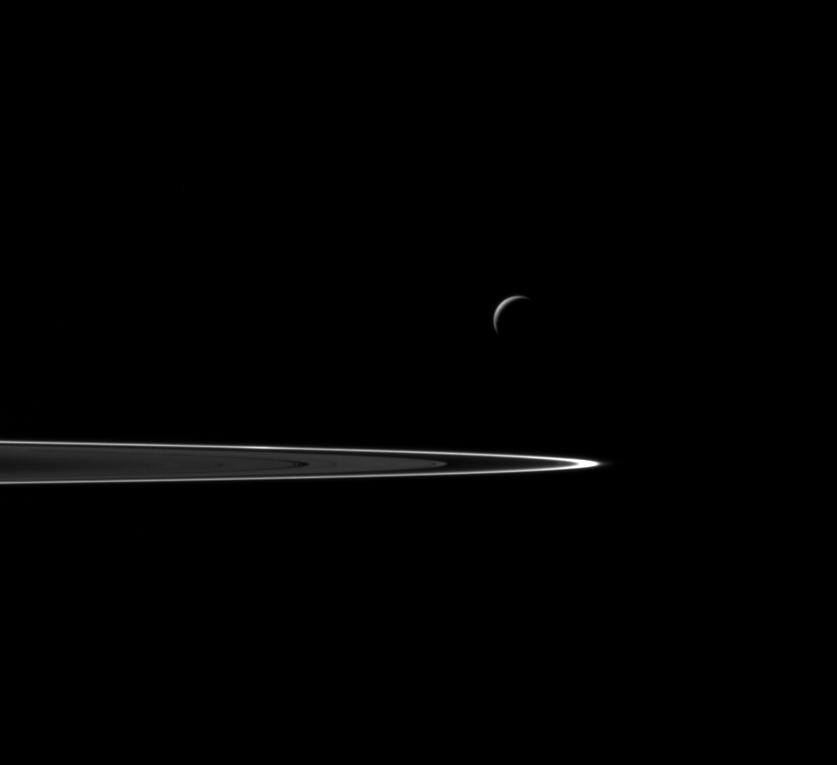
November 2, 2015, by Brigitte Nerlich
‘Serendipity carried through to perfection’ – thoughts on the Cassini mission
I am, as some of you might have noticed, an avid follower of …. not fashion but space exploration. I have ‘flown with’ Hubble, Voyager, Rosetta, Philae and New Horizons; I ‘follow’ Curiosity’s progress on Mars; and now I am entranced by some of the images that Cassini is sending back from Saturn and its moon Enceladus, discovered in 1789 by William Herschel. Cassini started its voyage in 1997 and has been circling and studying Saturn and its many moons since 2004. It is now searching for signs of ‘life’ in Enceladus’ gas and ice plumes. “The scientific mission will reach its end in 2017, when the spacecraft is expected to make a final dive into the atmosphere of Saturn.” (TechTimes)
Space and us
Why do I (and probably millions of others) care? I think space missions, space crafts, space probes, space robots, space telescopes, space observatories… and above all the space images they beam back, from Hubble, to Herschel to Huygens (the lander that Cassini dropped on Saturn’s moon Titan in 2005), take us out of ourselves and make us look back on ourselves from a different, wider, angle. Space exploration makes life on earth a little bit more worth living and it makes us appreciate this little speck of life that’s our planet. But beyond these rather airy-fairy words and feelings, there is something more down to earth going on which is also rather inspiring and important.
International space science
As Carolyn Porco, a planetary scientist who leads the imaging science team on the Cassini mission, has repeatedly stressed, this mission (like many others) shows what can be done when nations unite in a common and public effort. In a 2007 TED talk she said: “This is an international mission, and this event was celebrated in Europe, in Germany, and the celebratory presentations were given in English accents, and American accents, and German accents, and French and Italian and Dutch accents. It was a moving demonstration of what the words ‘united nations’ are supposed to mean: a true union of nations joined together in a colossal effort for good.” She said so again in a brief clip (about 8.36 minutes in) that is part of a beautiful video on Cassini and the exploration of its moon Enceladus which itself is part of an article in the New York Times by Jason Drakeford, Dennis Overbye and Jonathan Corum, published on 28 October 2015.
Science and serendipity
The video also contains another thought-provoking quote (about 4.49 minutes in) by Chris McKay, an astrobiologist at NASA’s Ames Research Center. When talking about Cassini probing the geysers spewing out of Saturn’s moon, he points out how remarkable it really is that Cassini discovered these icy plumes in the first place and then adapted its instruments to study them (obviously with a bit of help from humans down on earth!). He then said that this is “serendipity carried through to perfection”. This is another reason why, I think, I have fallen in love with space. What’s going on there in terms of ‘doing a science’, as Sarcastic Rover would call it, is a pretty good representation of what science, at least some of it, is or should be and, above all, should remain in the future – ‘serendipity carried through to perfection’! And, of course, the same can be said about art and culture, which, in the case of space exploration, nicely intermingles with science.
Images and visualisations
Alongside the united international efforts that go into space exploration and space imaging projects, there is of course also competition, something very nicely explored in this new book entitled Cosmos: The infographic book of space, by Stuart Lowe and Chris North. On their visualisation/infographic of space missions, you can see Saturn down at the bottom towards the left!
While not everybody can explore space, this book provides us with a little bit of space to explore space missions vicariously. Read these infographics alongside looking at the pictures and images that various space probes are beaming down to earth — and enjoy! The “achingly beautiful” image I have chosen for this post, was taken “in visible light with the Cassini spacecraft wide-angle camera on Oct. 28, 2015. The view was acquired at a distance of approximately 106,000 miles (171,000 kilometers) from Enceladus and at a Sun-Enceladus-spacecraft, or phase, angle of 141 degrees.” William and Caroline Herschel would have loved it!
Added, 13 August 2017: Cassini and Titan; Cassini is starting its final mission
Added 10 September 2017: Last Enceladus plume observation HT @carlzimmer
Added 16 September 2017: And here is Cassini’s last image
[Image credit: NASA/JPL-Caltech/Space Science Institute]
No comments yet, fill out a comment to be the first

Leave a Reply